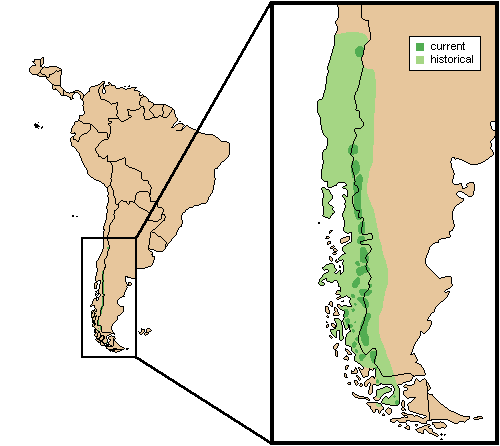Kingdom: |
Animalia Chordata Mammalia Artiodactyla Ruminantia Cervidae Capreolinae Odocoileini Hippocamelus |
Common name:
Scientific name:
Other names:
|
Patagonian huemul
Hippocamelus bisulcus
South Andean huemul, Chilean huemul, Huémul des Andes méridionales,
Huemul du Chili, Südlicher Andenhirsch, Huemul Patagónico, Ciervo
Andino meridional
|
Physical Characteristics
-
Head and body length: 140-175 cm
- Shoulder height: 80-90 cm
- Tail length: 13 cm
- Adult weight: 70-100 kg
- Shoulder height: 80-90 cm
The coarse coat is generally dark brown, although the color is richer in the summer (dark rusty-brown or coffee-colored) and paler (more greyish) in winter. The undersides are very light in color, and the short tail is white underneath. The outer layer of guard hairs in the coat may be 5-7 cm long in the winter, and 3-4 cm long in summer. Huemuls have relatively short legs which accentuate the hunched back. Male huemul have a dark stripe on the bridge of their nose, which forks in between the eyes and forms a pair of dark eyebrows (females may have this blaze, too). The large ears are sometimes described as "donkey-like". Only males grow antlers, which usually have a single branch. The rear tine is usually longer, growing 30-35 cm from the antler base.
-
Similar species
- The taruca (Hippocamelus antisensis) is easily separated from the Patagonian huemul by range in the wild. Physically, taruca tend to be smaller and lighter in color than Patagonian huemul.
Reproduction and Development
-
Gestation period: Reports vary; probably around 7 months.
- Litter size: 1.
- Weaning: 4-5 months.
- Sexual maturity: As early as 6 months.
- Life span: Up to 14 years.
- Litter size: 1.
The breeding season is between February and May, with most babies being born in November/December. Unlike many deer, baby huemuls do not have spots but are a solid dark brown color. Females give birth in isolated areas, where the baby can hide safely from predators. Babies lie hidden in such spots while their mothers forage.
Ecology and Behavior
-
Family group: Solitary or in small mixed groups of 2-5 animals. Groups
with multiple adult females are never seen.
- Diet: Leaves and tender shoots of shrubs and trees, very rarely grass.
- Main Predators: Puma, domestic dogs; foxes, small cats, and birds of prey may hunt young huemuls.
- Diet: Leaves and tender shoots of shrubs and trees, very rarely grass.
Habitat and Distribution

Conservation Status
-
IUCN Red List: Endangered (2008).
- CITES Listing: Appendix I (2009).
- Threats: Hunting, habitat loss, depredation by domestic dogs, diseases and competition from introduced wildlife and livestock.
- CITES Listing: Appendix I (2009).
The estimated total population is less than 1,500 animals, two-thirds of which live in Chile.






